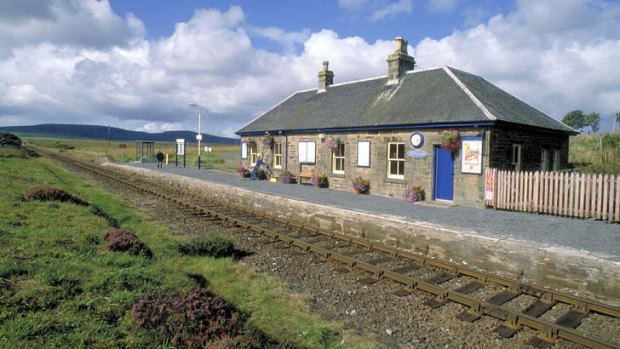
Making tracks: Scotscalder station on the Far North Line.Credit: Getty Images
Fifty years after Britain's train network was slashed, Stephen McClarence revisits lines spared the axe.
In the 1960s, as Dr Beeching was wielding his axe over the British rail network, the comedy duo Flanders and Swann wrote a wistful little song called Slow Train. With a chuff-chuffing piano accompaniment, they wove their lyrics out of the names of threatened stations:
"No more will I go to Blandford Forum and Mortehoe
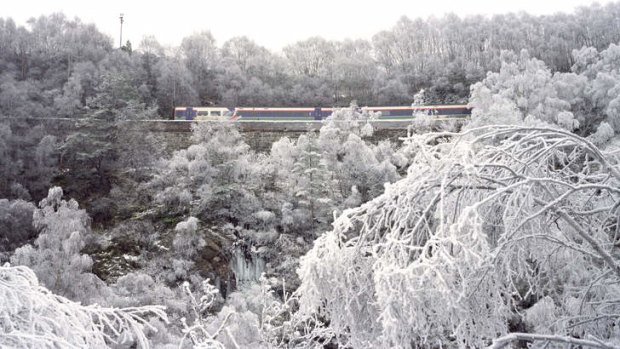
Falls of Shin on the Far North Line.Credit: Getty Images
On the slow train from Midsomer Norton and Mumby Road.
No churns, no porter, no cat on a seat
At Chorlton-cum-Hardy or Chester-le-Street.
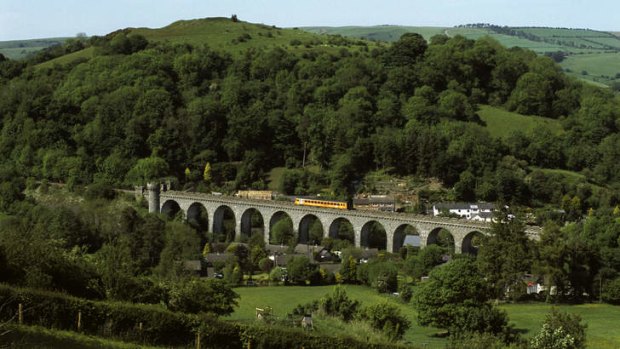
A train over the Knucklas Viaduct, Heart of Wales Line.Credit: Alamy
We won't be meeting again
On the Slow Train."
It was a song for an era about to end. It has been 50 years since the delivery of the Beeching report, which set out to make Britain's railway system pay its way. Dr Richard Beeching, a businessman who became chairman of the British Railways Board, wanted to close dozens of under-used and unprofitable branch lines, most of them rural or industrial. He recommended that more than 2300 stations should go, along with 8046 kilometres of the 29,000-kilometre rail network.
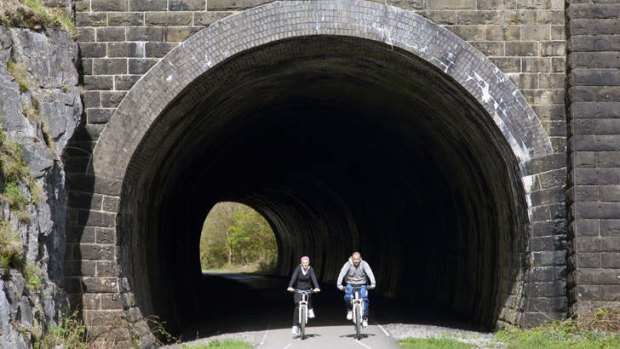
An old line converted into the Monsal Bike Trail, west Yorkshire.Credit: Getty Images
So eagerly were his proposals grasped that the first closures came months before the report was actually published. The Shropshire Line from Wellington to Buildwas and Much Wenlock closed in July 1962, followed by Wolverhampton-to-Stourbridge and Bewdley-to-Tenbury Wells. No rural halt was safe. To some, Beeching was a hero; to others, mindful of communities being cut off, he was a villain. There is no sterner critic than Julian Holland, author of Dr Beeching's Axe 50 Years On. The cuts were "senseless destruction", he says, carried through "for the sake of a politically motivated love affair with road transport". His book, packed with nostalgic photographs of steam locomotives, aims to include every line that was closed. Equally interesting, though, are the lines scheduled for closure that were reprieved.
They include some of Britain's most scenic rail journeys, most famously the Settle-to-Carlisle Line, voted the world's second-best train trip a couple of years ago (South Africa's Blue Train won). But there are plenty of others worth taking just for their own sake. Here are four "Slow Trains" that Flanders and Swann would undoubtedly have enjoyed.
The Far North Line
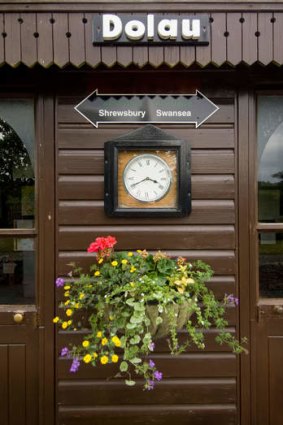
Quaint anachronism at Dolau station in Wales.Credit: Alamy
Britain's most northerly line runs from Inverness to Thurso in the top right-hand corner of Scotland. Had it closed, there would have been no trains north of the city and no rail link to Thurso, where nearby Scrabster is a departure point for ferries to the Orkney Islands. The line, which also branches off to Wick, meanders through 257 kilometres in a little less than four hours. It threads through valleys that witnessed a Victorian gold rush, passes small harbours and skirts seaside towns.
It sometimes hugs the coast so closely that it's almost on the beach; the silvery-blue water shimmers in the sunshine and, around Brora, cormorants perch on rocks drying their wings while seals bask on the sands. A highlight is the half-timbered station at Dunrobin Castle, built for his own use by the Duke of Sutherland. Daunting highland peaks loom on the horizon.
Perhaps the most fascinating stretch comes when the train veers inland across the great, flat Flow Country of Caithness. This is one of Britain's last wildernesses, mile after sweeping mile of very little apart from a lovat-and-beige expanse of small lochs, bog and pine trees. On a glowering grey day, the line has an uncompromising remoteness as it passes abandoned crofts, battered line-side snow fences, and isolated hotels and hunting lodges.
People with rucksacks get off at unmanned stations and fade into the distance. The journey is wild and strange. It feels like real exploration.
Friends of the Far North Line, see fofnl.org.uk; visithighlands.com.
The Hope Valley Line
The train pulls out of Sheffield, speeds past parks and retail parks, reaches the city's outer suburbs, and plunges into the Totley tunnel. Three-and-a-half miles later, it emerges into another world.
Opening out on either side is a panorama of the Derbyshire Peak District, some of Britain's most exhilarating walking country.
On the left are high, bald moors; on the right, the handsome village of Hathersage, full of associations with Charlotte Bronte and Robin Hood's Little John, reputedly buried in the churchyard on the hill. The landscape is spectacular at any time of year but in winter, covered with an eiderdown of snow, it takes on a Brueghelesque character.
The line, which Beeching originally planned to close between Dore (Sheffield) and Stockport, carries on to Manchester, the other city that has always regarded the Peak District as its weekend escape from the factories (in the days when there were still factories).
This is traditionally a walker's line. You can join the start of the Pennine Way from Edale station and try your luck with Kinder Scout, the Peak District's highest point and the start of the famous 1932 Mass Trespass (avoid this route in bad weather).
Fast through-trains run on the Hope Valley Line, covering Sheffield-Manchester in less than an hour. But the slower "stopping trains" are the key to it.
Cheerful with rucksack-laden ramblers equipped with home-made cheese sandwiches, they have a holiday atmosphere. Change at Stockport and you can join another scenic line that survived Beeching: to Buxton, the highest market town in England.
High Peak and Hope Valley Community Rail Partnership, see hvhptp.org.uk; visitpeakdistrict.com.
The Heart of Wales Line
For four hours, the train makes its steady 120-mile way down through Shropshire and Wales from Shrewsbury, whose skyline bristles with church spires and towers, to Swansea, taking in Llandovery, Llanwrda, Llangadog, Llandeilo and Llangennech. It's an "Ll" of a journey.
Sometimes just one coach long in winter and two in summer, the line (Beeching wanted to close the stretch between Craven Arms and Llanelli) has 30 or so stops, many only on request. It's one of Britain's most consistently rural runs, with one or two stations so isolated that sheep must be the only potential passengers.
Before you cross the border there are fine views of Wenlock Edge and the Long Mynd, where Iron Age and Roman reminders abound. The fortified towers of Knucklas Viaduct are a landmark.
Red kites wheel over the trees near Cynghordy, and the Black Mountains and Sugar Loaf Mountain loom; you feel immersed deep in rural Wales. Once busy with people off to take the waters at spas such as Llandrindod Wells and Builth Wells, it's now the most practical of scenic lines with passengers getting on with bags of shopping to take home.
Make a round trip to Shrewsbury on the train from Swansea to Cardiff and Newport, joining the Welsh Marches Line through Hereford, Leominster and Ludlow (strong on castles; Stokesay steals the show).
See heart-of-wales.co.uk; visitwales.co.uk. An Explore Wales Pass (www.explorewalespass.co.uk) accesses all Wales' mainline train services and many bus routes, £94 ($138) from Arriva Trains Wales. It runs for eight consecutive days, allowing four days' train and eight days' bus travel.
The Esk Valley Line
The 56-kilometre Esk Valley Line, from Middlesbrough to Whitby, is a second cousin of the more celebrated Settle-Carlisle. For about 90 minutes, the train twists and turns through some of England's most rugged moorland, much of the time through the North York Moors National Park.
The route, full of heroic Victorian engineering, takes in long rolling valleys and hills with pines clustered on top.
It passes salmon streams, buttercup meadows and bluebell woods, with hawthorn branches sometimes brushing the windows and pheasants and rabbits scattering as you pass. The stone stations have such a period feel that you half expect a cheery red-faced porter to bustle along the platform with a trolley for your luggage.
Part of the line's function is to ferry schoolchildren from outlying villages into Whitby and take them home. On school days, the afternoon train back can be boisterously St Trinian's.
Otherwise, the passengers include walkers and men in tweed jackets visiting friends in neighbouring villages.
At Grosmont, 20 minutes out of Whitby, the "heritage" North Yorkshire Moors Railway joins the Esk Valley after its scenic journey up from Pickering on a line axed by Beeching in 1965 but subsequently rescued.
On the Whitby platform, near the excellent Whistlestop Tea Rooms, is a Victorian cream-tiled wall map of the Yorkshire rail network in the days when it stretched its tentacles to the county's most remote corners.
Even the tiniest villages had stations linking them to the outside world: Sexhow and Potto, Danby Wiske and Boosbeck. Cue Flanders and Swann.
See eskvalleyrailway.co.uk; www.visityorkshire.co.uk.
Telegraph, London
Sign up for the Traveller Deals newsletter
Get exclusive travel deals delivered straight to your inbox. Sign up now.